First Peoples' Health in Australia: Essay on Health Strategies
VerifiedAdded on 2022/10/03
|9
|3052
|21
Essay
AI Summary
This essay explores the significant health disparities experienced by Aboriginal and Torres Strait Islander peoples in Australia. It highlights the higher prevalence of diseases, lower life expectancy, and the impact of social, cultural, and economic factors on their health outcomes. The essay examines contemporary healthcare strategies, with a focus on community engagement as a key approach to improving health services and building trust. It discusses the importance of culturally appropriate care, the role of Aboriginal Health Workers, and the implementation of programs like Closing the Gap. The essay also emphasizes the influence of socio-economic disadvantages, poor nutrition, and behavioral risk factors on the health of Indigenous Australians, concluding that effective healthcare requires culturally sensitive strategies and active community participation.
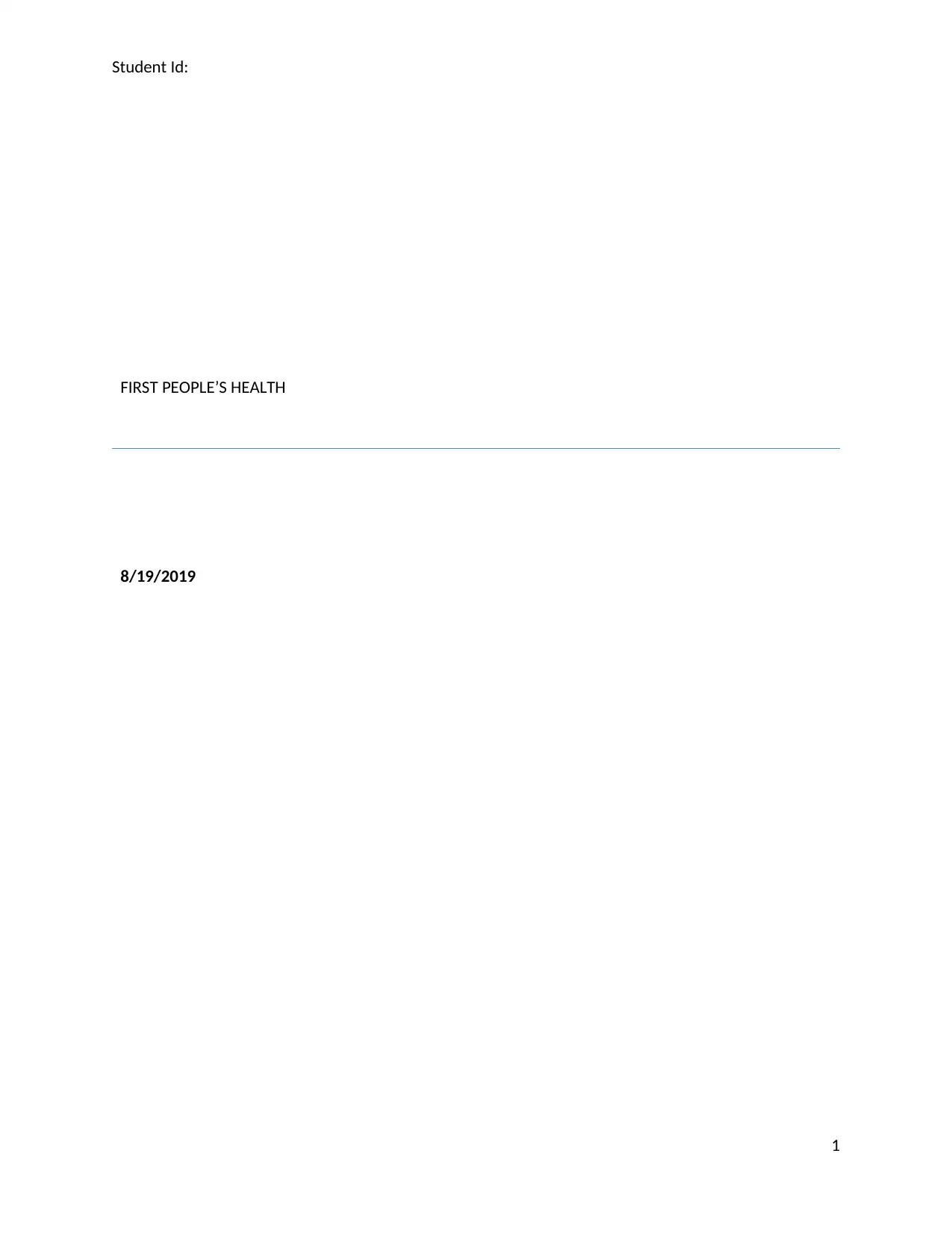
Student Id:
FIRST PEOPLE’S HEALTH
8/19/2019
1
FIRST PEOPLE’S HEALTH
8/19/2019
1
Paraphrase This Document
Need a fresh take? Get an instant paraphrase of this document with our AI Paraphraser
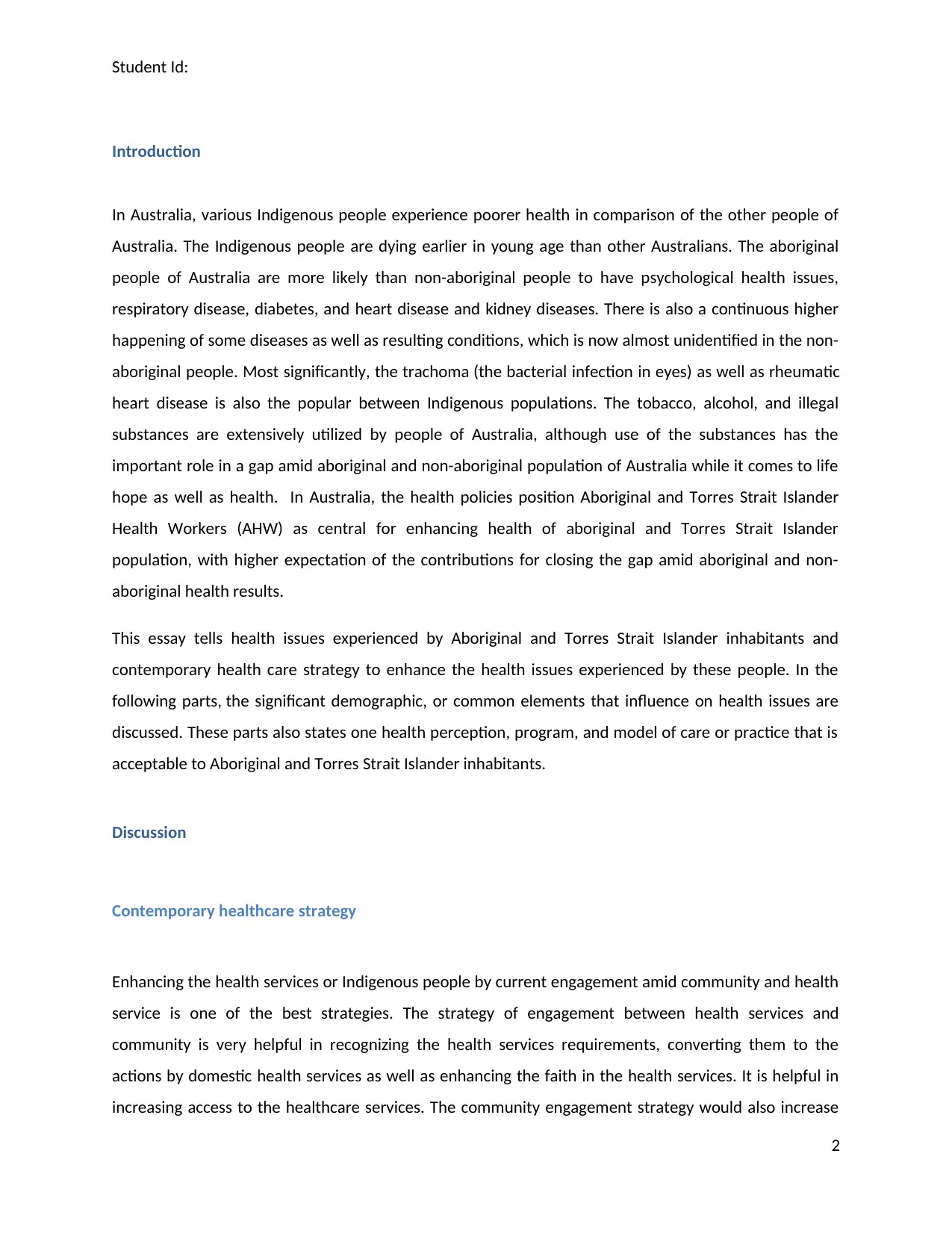
Student Id:
Introduction
In Australia, various Indigenous people experience poorer health in comparison of the other people of
Australia. The Indigenous people are dying earlier in young age than other Australians. The aboriginal
people of Australia are more likely than non-aboriginal people to have psychological health issues,
respiratory disease, diabetes, and heart disease and kidney diseases. There is also a continuous higher
happening of some diseases as well as resulting conditions, which is now almost unidentified in the non-
aboriginal people. Most significantly, the trachoma (the bacterial infection in eyes) as well as rheumatic
heart disease is also the popular between Indigenous populations. The tobacco, alcohol, and illegal
substances are extensively utilized by people of Australia, although use of the substances has the
important role in a gap amid aboriginal and non-aboriginal population of Australia while it comes to life
hope as well as health. In Australia, the health policies position Aboriginal and Torres Strait Islander
Health Workers (AHW) as central for enhancing health of aboriginal and Torres Strait Islander
population, with higher expectation of the contributions for closing the gap amid aboriginal and non-
aboriginal health results.
This essay tells health issues experienced by Aboriginal and Torres Strait Islander inhabitants and
contemporary health care strategy to enhance the health issues experienced by these people. In the
following parts, the significant demographic, or common elements that influence on health issues are
discussed. These parts also states one health perception, program, and model of care or practice that is
acceptable to Aboriginal and Torres Strait Islander inhabitants.
Discussion
Contemporary healthcare strategy
Enhancing the health services or Indigenous people by current engagement amid community and health
service is one of the best strategies. The strategy of engagement between health services and
community is very helpful in recognizing the health services requirements, converting them to the
actions by domestic health services as well as enhancing the faith in the health services. It is helpful in
increasing access to the healthcare services. The community engagement strategy would also increase
2
Introduction
In Australia, various Indigenous people experience poorer health in comparison of the other people of
Australia. The Indigenous people are dying earlier in young age than other Australians. The aboriginal
people of Australia are more likely than non-aboriginal people to have psychological health issues,
respiratory disease, diabetes, and heart disease and kidney diseases. There is also a continuous higher
happening of some diseases as well as resulting conditions, which is now almost unidentified in the non-
aboriginal people. Most significantly, the trachoma (the bacterial infection in eyes) as well as rheumatic
heart disease is also the popular between Indigenous populations. The tobacco, alcohol, and illegal
substances are extensively utilized by people of Australia, although use of the substances has the
important role in a gap amid aboriginal and non-aboriginal population of Australia while it comes to life
hope as well as health. In Australia, the health policies position Aboriginal and Torres Strait Islander
Health Workers (AHW) as central for enhancing health of aboriginal and Torres Strait Islander
population, with higher expectation of the contributions for closing the gap amid aboriginal and non-
aboriginal health results.
This essay tells health issues experienced by Aboriginal and Torres Strait Islander inhabitants and
contemporary health care strategy to enhance the health issues experienced by these people. In the
following parts, the significant demographic, or common elements that influence on health issues are
discussed. These parts also states one health perception, program, and model of care or practice that is
acceptable to Aboriginal and Torres Strait Islander inhabitants.
Discussion
Contemporary healthcare strategy
Enhancing the health services or Indigenous people by current engagement amid community and health
service is one of the best strategies. The strategy of engagement between health services and
community is very helpful in recognizing the health services requirements, converting them to the
actions by domestic health services as well as enhancing the faith in the health services. It is helpful in
increasing access to the healthcare services. The community engagement strategy would also increase
2
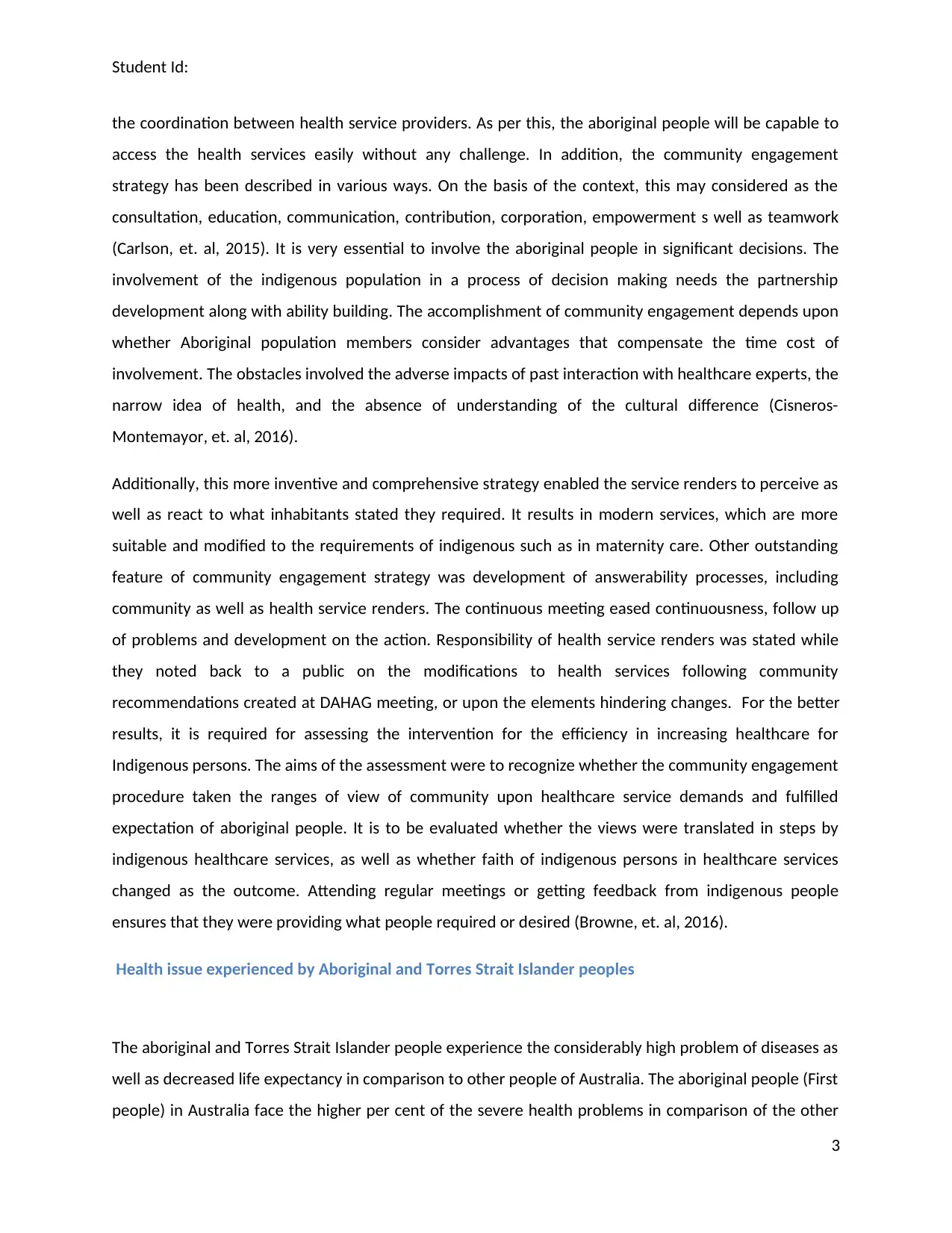
Student Id:
the coordination between health service providers. As per this, the aboriginal people will be capable to
access the health services easily without any challenge. In addition, the community engagement
strategy has been described in various ways. On the basis of the context, this may considered as the
consultation, education, communication, contribution, corporation, empowerment s well as teamwork
(Carlson, et. al, 2015). It is very essential to involve the aboriginal people in significant decisions. The
involvement of the indigenous population in a process of decision making needs the partnership
development along with ability building. The accomplishment of community engagement depends upon
whether Aboriginal population members consider advantages that compensate the time cost of
involvement. The obstacles involved the adverse impacts of past interaction with healthcare experts, the
narrow idea of health, and the absence of understanding of the cultural difference (Cisneros-
Montemayor, et. al, 2016).
Additionally, this more inventive and comprehensive strategy enabled the service renders to perceive as
well as react to what inhabitants stated they required. It results in modern services, which are more
suitable and modified to the requirements of indigenous such as in maternity care. Other outstanding
feature of community engagement strategy was development of answerability processes, including
community as well as health service renders. The continuous meeting eased continuousness, follow up
of problems and development on the action. Responsibility of health service renders was stated while
they noted back to a public on the modifications to health services following community
recommendations created at DAHAG meeting, or upon the elements hindering changes. For the better
results, it is required for assessing the intervention for the efficiency in increasing healthcare for
Indigenous persons. The aims of the assessment were to recognize whether the community engagement
procedure taken the ranges of view of community upon healthcare service demands and fulfilled
expectation of aboriginal people. It is to be evaluated whether the views were translated in steps by
indigenous healthcare services, as well as whether faith of indigenous persons in healthcare services
changed as the outcome. Attending regular meetings or getting feedback from indigenous people
ensures that they were providing what people required or desired (Browne, et. al, 2016).
Health issue experienced by Aboriginal and Torres Strait Islander peoples
The aboriginal and Torres Strait Islander people experience the considerably high problem of diseases as
well as decreased life expectancy in comparison to other people of Australia. The aboriginal people (First
people) in Australia face the higher per cent of the severe health problems in comparison of the other
3
the coordination between health service providers. As per this, the aboriginal people will be capable to
access the health services easily without any challenge. In addition, the community engagement
strategy has been described in various ways. On the basis of the context, this may considered as the
consultation, education, communication, contribution, corporation, empowerment s well as teamwork
(Carlson, et. al, 2015). It is very essential to involve the aboriginal people in significant decisions. The
involvement of the indigenous population in a process of decision making needs the partnership
development along with ability building. The accomplishment of community engagement depends upon
whether Aboriginal population members consider advantages that compensate the time cost of
involvement. The obstacles involved the adverse impacts of past interaction with healthcare experts, the
narrow idea of health, and the absence of understanding of the cultural difference (Cisneros-
Montemayor, et. al, 2016).
Additionally, this more inventive and comprehensive strategy enabled the service renders to perceive as
well as react to what inhabitants stated they required. It results in modern services, which are more
suitable and modified to the requirements of indigenous such as in maternity care. Other outstanding
feature of community engagement strategy was development of answerability processes, including
community as well as health service renders. The continuous meeting eased continuousness, follow up
of problems and development on the action. Responsibility of health service renders was stated while
they noted back to a public on the modifications to health services following community
recommendations created at DAHAG meeting, or upon the elements hindering changes. For the better
results, it is required for assessing the intervention for the efficiency in increasing healthcare for
Indigenous persons. The aims of the assessment were to recognize whether the community engagement
procedure taken the ranges of view of community upon healthcare service demands and fulfilled
expectation of aboriginal people. It is to be evaluated whether the views were translated in steps by
indigenous healthcare services, as well as whether faith of indigenous persons in healthcare services
changed as the outcome. Attending regular meetings or getting feedback from indigenous people
ensures that they were providing what people required or desired (Browne, et. al, 2016).
Health issue experienced by Aboriginal and Torres Strait Islander peoples
The aboriginal and Torres Strait Islander people experience the considerably high problem of diseases as
well as decreased life expectancy in comparison to other people of Australia. The aboriginal people (First
people) in Australia face the higher per cent of the severe health problems in comparison of the other
3
⊘ This is a preview!⊘
Do you want full access?
Subscribe today to unlock all pages.

Trusted by 1+ million students worldwide
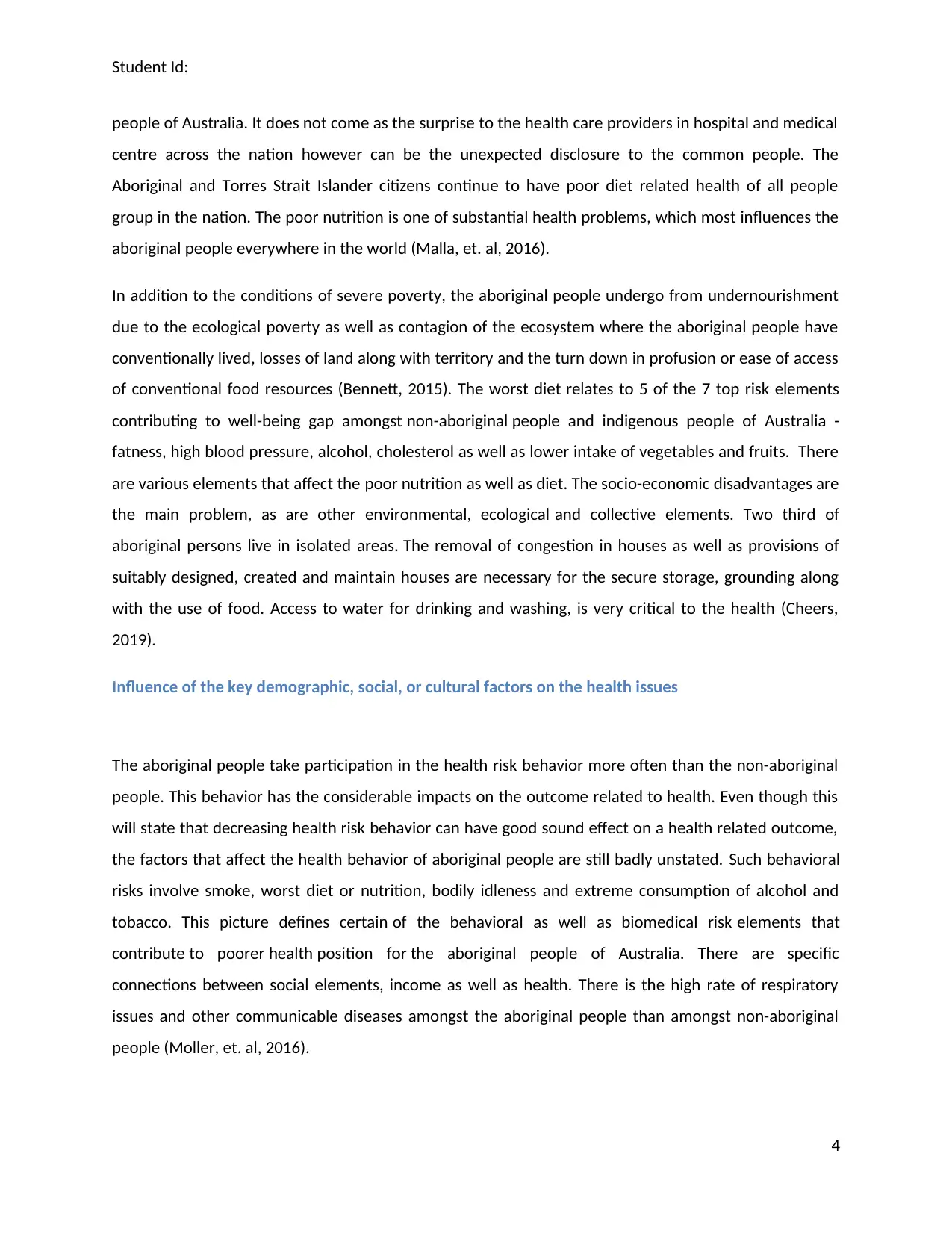
Student Id:
people of Australia. It does not come as the surprise to the health care providers in hospital and medical
centre across the nation however can be the unexpected disclosure to the common people. The
Aboriginal and Torres Strait Islander citizens continue to have poor diet related health of all people
group in the nation. The poor nutrition is one of substantial health problems, which most influences the
aboriginal people everywhere in the world (Malla, et. al, 2016).
In addition to the conditions of severe poverty, the aboriginal people undergo from undernourishment
due to the ecological poverty as well as contagion of the ecosystem where the aboriginal people have
conventionally lived, losses of land along with territory and the turn down in profusion or ease of access
of conventional food resources (Bennett, 2015). The worst diet relates to 5 of the 7 top risk elements
contributing to well-being gap amongst non-aboriginal people and indigenous people of Australia -
fatness, high blood pressure, alcohol, cholesterol as well as lower intake of vegetables and fruits. There
are various elements that affect the poor nutrition as well as diet. The socio-economic disadvantages are
the main problem, as are other environmental, ecological and collective elements. Two third of
aboriginal persons live in isolated areas. The removal of congestion in houses as well as provisions of
suitably designed, created and maintain houses are necessary for the secure storage, grounding along
with the use of food. Access to water for drinking and washing, is very critical to the health (Cheers,
2019).
Influence of the key demographic, social, or cultural factors on the health issues
The aboriginal people take participation in the health risk behavior more often than the non-aboriginal
people. This behavior has the considerable impacts on the outcome related to health. Even though this
will state that decreasing health risk behavior can have good sound effect on a health related outcome,
the factors that affect the health behavior of aboriginal people are still badly unstated. Such behavioral
risks involve smoke, worst diet or nutrition, bodily idleness and extreme consumption of alcohol and
tobacco. This picture defines certain of the behavioral as well as biomedical risk elements that
contribute to poorer health position for the aboriginal people of Australia. There are specific
connections between social elements, income as well as health. There is the high rate of respiratory
issues and other communicable diseases amongst the aboriginal people than amongst non-aboriginal
people (Moller, et. al, 2016).
4
people of Australia. It does not come as the surprise to the health care providers in hospital and medical
centre across the nation however can be the unexpected disclosure to the common people. The
Aboriginal and Torres Strait Islander citizens continue to have poor diet related health of all people
group in the nation. The poor nutrition is one of substantial health problems, which most influences the
aboriginal people everywhere in the world (Malla, et. al, 2016).
In addition to the conditions of severe poverty, the aboriginal people undergo from undernourishment
due to the ecological poverty as well as contagion of the ecosystem where the aboriginal people have
conventionally lived, losses of land along with territory and the turn down in profusion or ease of access
of conventional food resources (Bennett, 2015). The worst diet relates to 5 of the 7 top risk elements
contributing to well-being gap amongst non-aboriginal people and indigenous people of Australia -
fatness, high blood pressure, alcohol, cholesterol as well as lower intake of vegetables and fruits. There
are various elements that affect the poor nutrition as well as diet. The socio-economic disadvantages are
the main problem, as are other environmental, ecological and collective elements. Two third of
aboriginal persons live in isolated areas. The removal of congestion in houses as well as provisions of
suitably designed, created and maintain houses are necessary for the secure storage, grounding along
with the use of food. Access to water for drinking and washing, is very critical to the health (Cheers,
2019).
Influence of the key demographic, social, or cultural factors on the health issues
The aboriginal people take participation in the health risk behavior more often than the non-aboriginal
people. This behavior has the considerable impacts on the outcome related to health. Even though this
will state that decreasing health risk behavior can have good sound effect on a health related outcome,
the factors that affect the health behavior of aboriginal people are still badly unstated. Such behavioral
risks involve smoke, worst diet or nutrition, bodily idleness and extreme consumption of alcohol and
tobacco. This picture defines certain of the behavioral as well as biomedical risk elements that
contribute to poorer health position for the aboriginal people of Australia. There are specific
connections between social elements, income as well as health. There is the high rate of respiratory
issues and other communicable diseases amongst the aboriginal people than amongst non-aboriginal
people (Moller, et. al, 2016).
4
Paraphrase This Document
Need a fresh take? Get an instant paraphrase of this document with our AI Paraphraser
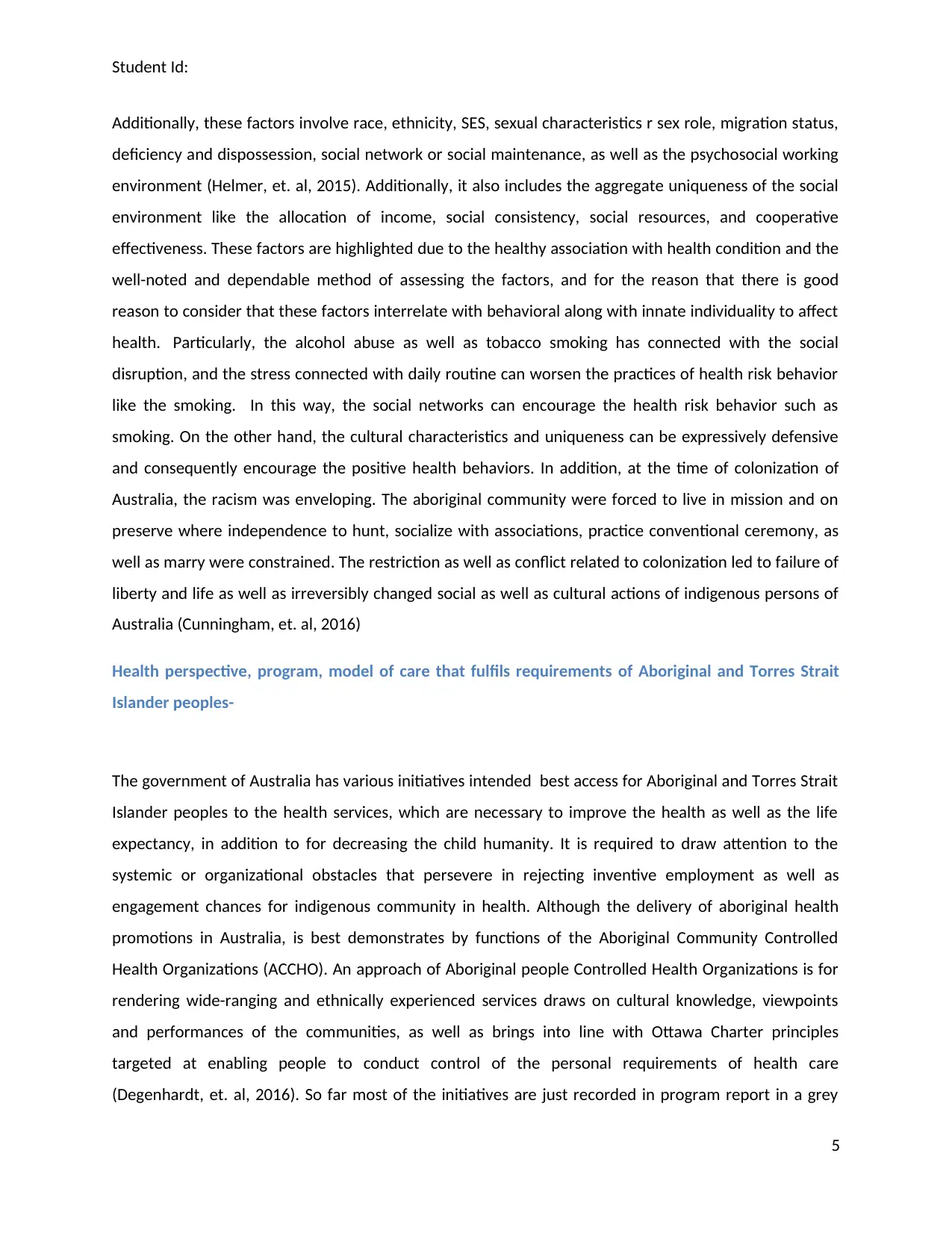
Student Id:
Additionally, these factors involve race, ethnicity, SES, sexual characteristics r sex role, migration status,
deficiency and dispossession, social network or social maintenance, as well as the psychosocial working
environment (Helmer, et. al, 2015). Additionally, it also includes the aggregate uniqueness of the social
environment like the allocation of income, social consistency, social resources, and cooperative
effectiveness. These factors are highlighted due to the healthy association with health condition and the
well-noted and dependable method of assessing the factors, and for the reason that there is good
reason to consider that these factors interrelate with behavioral along with innate individuality to affect
health. Particularly, the alcohol abuse as well as tobacco smoking has connected with the social
disruption, and the stress connected with daily routine can worsen the practices of health risk behavior
like the smoking. In this way, the social networks can encourage the health risk behavior such as
smoking. On the other hand, the cultural characteristics and uniqueness can be expressively defensive
and consequently encourage the positive health behaviors. In addition, at the time of colonization of
Australia, the racism was enveloping. The aboriginal community were forced to live in mission and on
preserve where independence to hunt, socialize with associations, practice conventional ceremony, as
well as marry were constrained. The restriction as well as conflict related to colonization led to failure of
liberty and life as well as irreversibly changed social as well as cultural actions of indigenous persons of
Australia (Cunningham, et. al, 2016)
Health perspective, program, model of care that fulfils requirements of Aboriginal and Torres Strait
Islander peoples-
The government of Australia has various initiatives intended best access for Aboriginal and Torres Strait
Islander peoples to the health services, which are necessary to improve the health as well as the life
expectancy, in addition to for decreasing the child humanity. It is required to draw attention to the
systemic or organizational obstacles that persevere in rejecting inventive employment as well as
engagement chances for indigenous community in health. Although the delivery of aboriginal health
promotions in Australia, is best demonstrates by functions of the Aboriginal Community Controlled
Health Organizations (ACCHO). An approach of Aboriginal people Controlled Health Organizations is for
rendering wide-ranging and ethnically experienced services draws on cultural knowledge, viewpoints
and performances of the communities, as well as brings into line with Ottawa Charter principles
targeted at enabling people to conduct control of the personal requirements of health care
(Degenhardt, et. al, 2016). So far most of the initiatives are just recorded in program report in a grey
5
Additionally, these factors involve race, ethnicity, SES, sexual characteristics r sex role, migration status,
deficiency and dispossession, social network or social maintenance, as well as the psychosocial working
environment (Helmer, et. al, 2015). Additionally, it also includes the aggregate uniqueness of the social
environment like the allocation of income, social consistency, social resources, and cooperative
effectiveness. These factors are highlighted due to the healthy association with health condition and the
well-noted and dependable method of assessing the factors, and for the reason that there is good
reason to consider that these factors interrelate with behavioral along with innate individuality to affect
health. Particularly, the alcohol abuse as well as tobacco smoking has connected with the social
disruption, and the stress connected with daily routine can worsen the practices of health risk behavior
like the smoking. In this way, the social networks can encourage the health risk behavior such as
smoking. On the other hand, the cultural characteristics and uniqueness can be expressively defensive
and consequently encourage the positive health behaviors. In addition, at the time of colonization of
Australia, the racism was enveloping. The aboriginal community were forced to live in mission and on
preserve where independence to hunt, socialize with associations, practice conventional ceremony, as
well as marry were constrained. The restriction as well as conflict related to colonization led to failure of
liberty and life as well as irreversibly changed social as well as cultural actions of indigenous persons of
Australia (Cunningham, et. al, 2016)
Health perspective, program, model of care that fulfils requirements of Aboriginal and Torres Strait
Islander peoples-
The government of Australia has various initiatives intended best access for Aboriginal and Torres Strait
Islander peoples to the health services, which are necessary to improve the health as well as the life
expectancy, in addition to for decreasing the child humanity. It is required to draw attention to the
systemic or organizational obstacles that persevere in rejecting inventive employment as well as
engagement chances for indigenous community in health. Although the delivery of aboriginal health
promotions in Australia, is best demonstrates by functions of the Aboriginal Community Controlled
Health Organizations (ACCHO). An approach of Aboriginal people Controlled Health Organizations is for
rendering wide-ranging and ethnically experienced services draws on cultural knowledge, viewpoints
and performances of the communities, as well as brings into line with Ottawa Charter principles
targeted at enabling people to conduct control of the personal requirements of health care
(Degenhardt, et. al, 2016). So far most of the initiatives are just recorded in program report in a grey
5
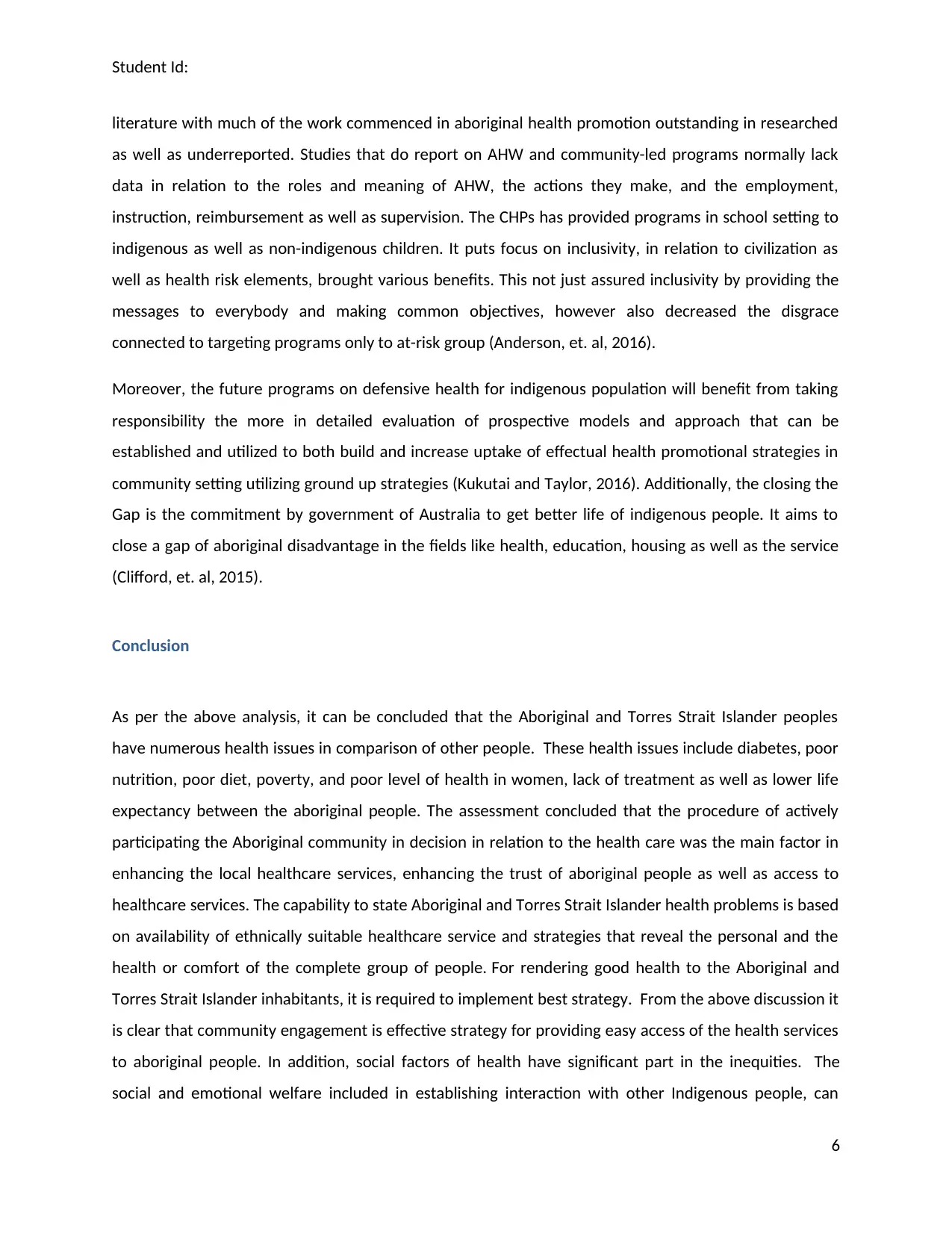
Student Id:
literature with much of the work commenced in aboriginal health promotion outstanding in researched
as well as underreported. Studies that do report on AHW and community-led programs normally lack
data in relation to the roles and meaning of AHW, the actions they make, and the employment,
instruction, reimbursement as well as supervision. The CHPs has provided programs in school setting to
indigenous as well as non-indigenous children. It puts focus on inclusivity, in relation to civilization as
well as health risk elements, brought various benefits. This not just assured inclusivity by providing the
messages to everybody and making common objectives, however also decreased the disgrace
connected to targeting programs only to at-risk group (Anderson, et. al, 2016).
Moreover, the future programs on defensive health for indigenous population will benefit from taking
responsibility the more in detailed evaluation of prospective models and approach that can be
established and utilized to both build and increase uptake of effectual health promotional strategies in
community setting utilizing ground up strategies (Kukutai and Taylor, 2016). Additionally, the closing the
Gap is the commitment by government of Australia to get better life of indigenous people. It aims to
close a gap of aboriginal disadvantage in the fields like health, education, housing as well as the service
(Clifford, et. al, 2015).
Conclusion
As per the above analysis, it can be concluded that the Aboriginal and Torres Strait Islander peoples
have numerous health issues in comparison of other people. These health issues include diabetes, poor
nutrition, poor diet, poverty, and poor level of health in women, lack of treatment as well as lower life
expectancy between the aboriginal people. The assessment concluded that the procedure of actively
participating the Aboriginal community in decision in relation to the health care was the main factor in
enhancing the local healthcare services, enhancing the trust of aboriginal people as well as access to
healthcare services. The capability to state Aboriginal and Torres Strait Islander health problems is based
on availability of ethnically suitable healthcare service and strategies that reveal the personal and the
health or comfort of the complete group of people. For rendering good health to the Aboriginal and
Torres Strait Islander inhabitants, it is required to implement best strategy. From the above discussion it
is clear that community engagement is effective strategy for providing easy access of the health services
to aboriginal people. In addition, social factors of health have significant part in the inequities. The
social and emotional welfare included in establishing interaction with other Indigenous people, can
6
literature with much of the work commenced in aboriginal health promotion outstanding in researched
as well as underreported. Studies that do report on AHW and community-led programs normally lack
data in relation to the roles and meaning of AHW, the actions they make, and the employment,
instruction, reimbursement as well as supervision. The CHPs has provided programs in school setting to
indigenous as well as non-indigenous children. It puts focus on inclusivity, in relation to civilization as
well as health risk elements, brought various benefits. This not just assured inclusivity by providing the
messages to everybody and making common objectives, however also decreased the disgrace
connected to targeting programs only to at-risk group (Anderson, et. al, 2016).
Moreover, the future programs on defensive health for indigenous population will benefit from taking
responsibility the more in detailed evaluation of prospective models and approach that can be
established and utilized to both build and increase uptake of effectual health promotional strategies in
community setting utilizing ground up strategies (Kukutai and Taylor, 2016). Additionally, the closing the
Gap is the commitment by government of Australia to get better life of indigenous people. It aims to
close a gap of aboriginal disadvantage in the fields like health, education, housing as well as the service
(Clifford, et. al, 2015).
Conclusion
As per the above analysis, it can be concluded that the Aboriginal and Torres Strait Islander peoples
have numerous health issues in comparison of other people. These health issues include diabetes, poor
nutrition, poor diet, poverty, and poor level of health in women, lack of treatment as well as lower life
expectancy between the aboriginal people. The assessment concluded that the procedure of actively
participating the Aboriginal community in decision in relation to the health care was the main factor in
enhancing the local healthcare services, enhancing the trust of aboriginal people as well as access to
healthcare services. The capability to state Aboriginal and Torres Strait Islander health problems is based
on availability of ethnically suitable healthcare service and strategies that reveal the personal and the
health or comfort of the complete group of people. For rendering good health to the Aboriginal and
Torres Strait Islander inhabitants, it is required to implement best strategy. From the above discussion it
is clear that community engagement is effective strategy for providing easy access of the health services
to aboriginal people. In addition, social factors of health have significant part in the inequities. The
social and emotional welfare included in establishing interaction with other Indigenous people, can
6
⊘ This is a preview!⊘
Do you want full access?
Subscribe today to unlock all pages.

Trusted by 1+ million students worldwide
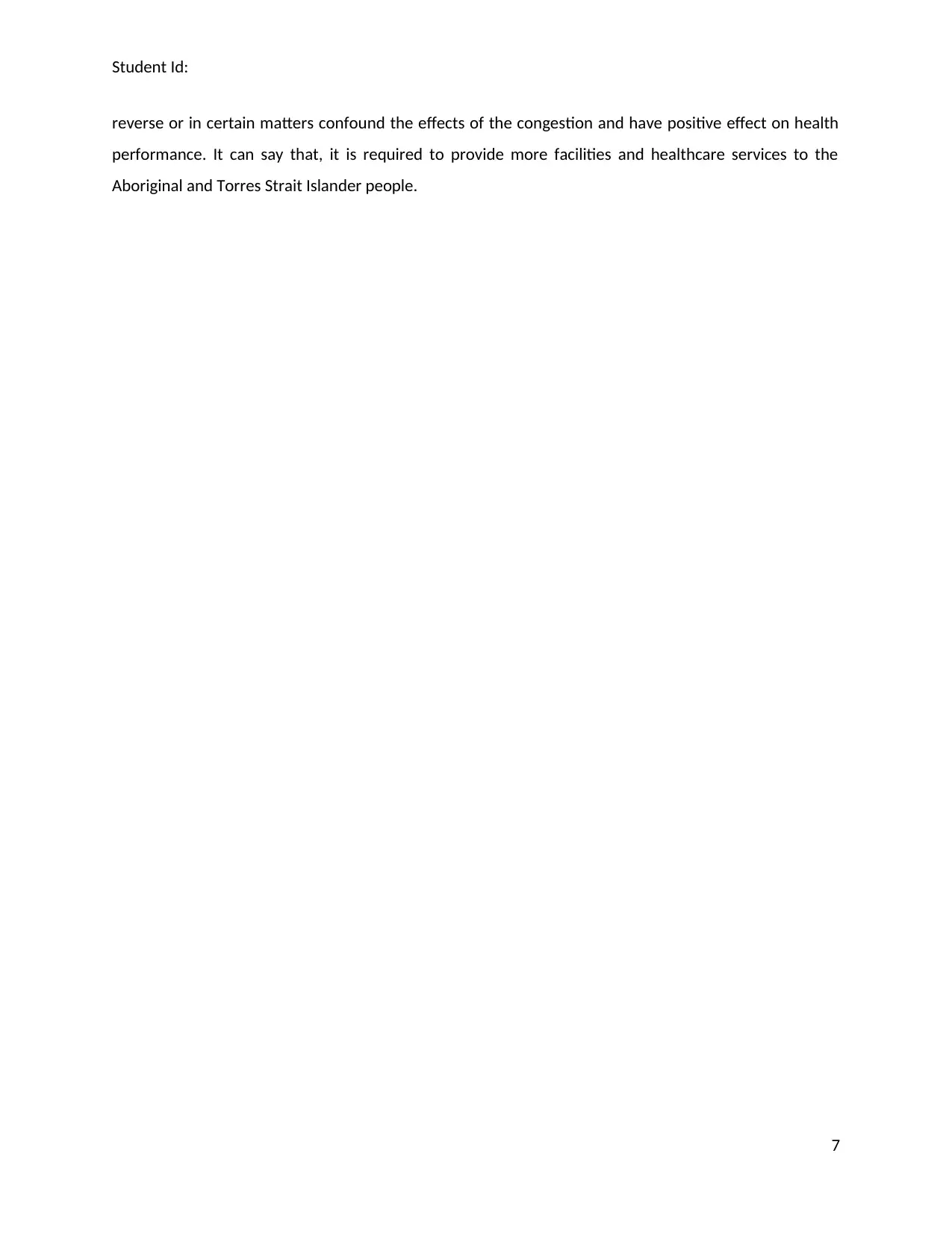
Student Id:
reverse or in certain matters confound the effects of the congestion and have positive effect on health
performance. It can say that, it is required to provide more facilities and healthcare services to the
Aboriginal and Torres Strait Islander people.
7
reverse or in certain matters confound the effects of the congestion and have positive effect on health
performance. It can say that, it is required to provide more facilities and healthcare services to the
Aboriginal and Torres Strait Islander people.
7
Paraphrase This Document
Need a fresh take? Get an instant paraphrase of this document with our AI Paraphraser
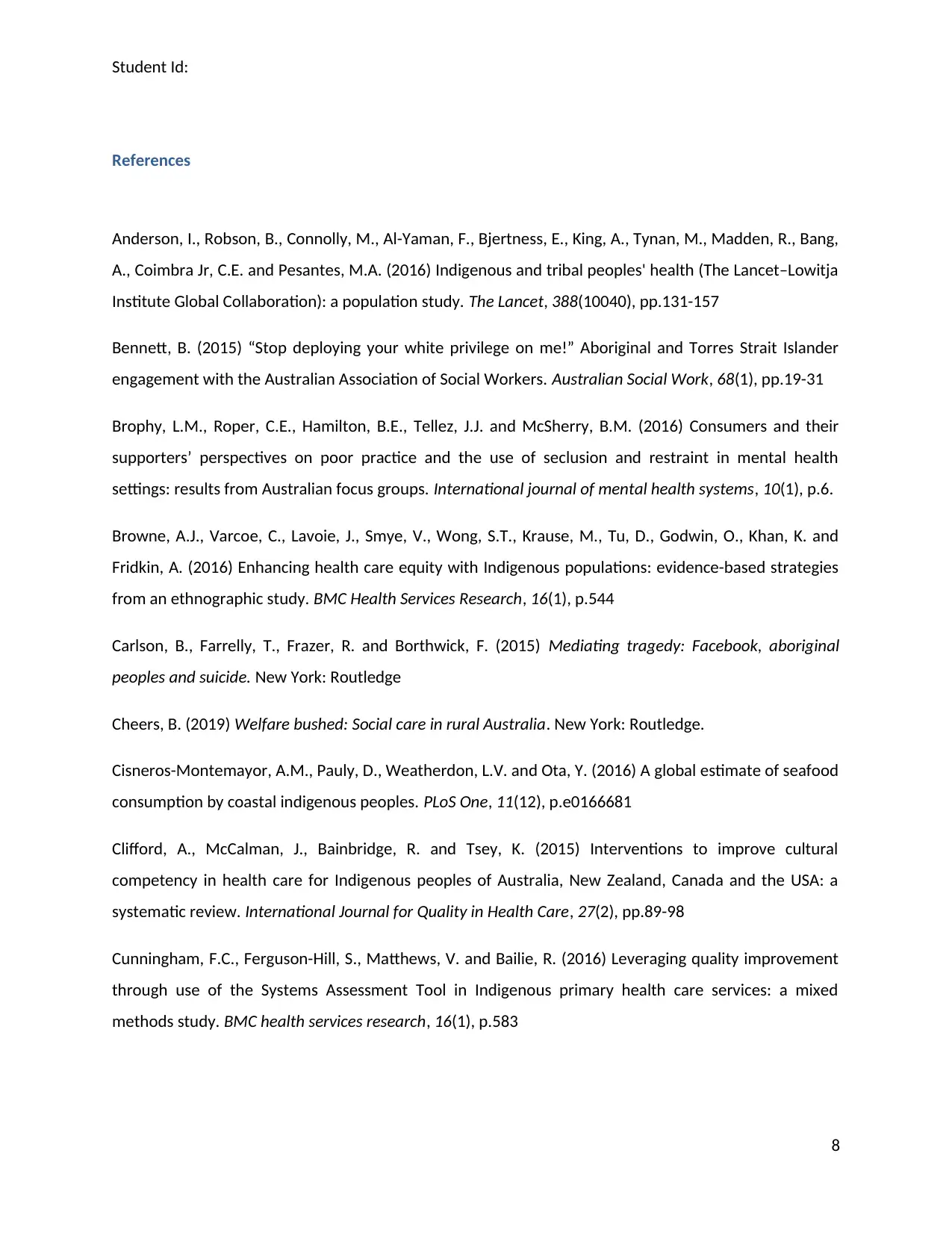
Student Id:
References
Anderson, I., Robson, B., Connolly, M., Al-Yaman, F., Bjertness, E., King, A., Tynan, M., Madden, R., Bang,
A., Coimbra Jr, C.E. and Pesantes, M.A. (2016) Indigenous and tribal peoples' health (The Lancet–Lowitja
Institute Global Collaboration): a population study. The Lancet, 388(10040), pp.131-157
Bennett, B. (2015) “Stop deploying your white privilege on me!” Aboriginal and Torres Strait Islander
engagement with the Australian Association of Social Workers. Australian Social Work, 68(1), pp.19-31
Brophy, L.M., Roper, C.E., Hamilton, B.E., Tellez, J.J. and McSherry, B.M. (2016) Consumers and their
supporters’ perspectives on poor practice and the use of seclusion and restraint in mental health
settings: results from Australian focus groups. International journal of mental health systems, 10(1), p.6.
Browne, A.J., Varcoe, C., Lavoie, J., Smye, V., Wong, S.T., Krause, M., Tu, D., Godwin, O., Khan, K. and
Fridkin, A. (2016) Enhancing health care equity with Indigenous populations: evidence-based strategies
from an ethnographic study. BMC Health Services Research, 16(1), p.544
Carlson, B., Farrelly, T., Frazer, R. and Borthwick, F. (2015) Mediating tragedy: Facebook, aboriginal
peoples and suicide. New York: Routledge
Cheers, B. (2019) Welfare bushed: Social care in rural Australia. New York: Routledge.
Cisneros-Montemayor, A.M., Pauly, D., Weatherdon, L.V. and Ota, Y. (2016) A global estimate of seafood
consumption by coastal indigenous peoples. PLoS One, 11(12), p.e0166681
Clifford, A., McCalman, J., Bainbridge, R. and Tsey, K. (2015) Interventions to improve cultural
competency in health care for Indigenous peoples of Australia, New Zealand, Canada and the USA: a
systematic review. International Journal for Quality in Health Care, 27(2), pp.89-98
Cunningham, F.C., Ferguson-Hill, S., Matthews, V. and Bailie, R. (2016) Leveraging quality improvement
through use of the Systems Assessment Tool in Indigenous primary health care services: a mixed
methods study. BMC health services research, 16(1), p.583
8
References
Anderson, I., Robson, B., Connolly, M., Al-Yaman, F., Bjertness, E., King, A., Tynan, M., Madden, R., Bang,
A., Coimbra Jr, C.E. and Pesantes, M.A. (2016) Indigenous and tribal peoples' health (The Lancet–Lowitja
Institute Global Collaboration): a population study. The Lancet, 388(10040), pp.131-157
Bennett, B. (2015) “Stop deploying your white privilege on me!” Aboriginal and Torres Strait Islander
engagement with the Australian Association of Social Workers. Australian Social Work, 68(1), pp.19-31
Brophy, L.M., Roper, C.E., Hamilton, B.E., Tellez, J.J. and McSherry, B.M. (2016) Consumers and their
supporters’ perspectives on poor practice and the use of seclusion and restraint in mental health
settings: results from Australian focus groups. International journal of mental health systems, 10(1), p.6.
Browne, A.J., Varcoe, C., Lavoie, J., Smye, V., Wong, S.T., Krause, M., Tu, D., Godwin, O., Khan, K. and
Fridkin, A. (2016) Enhancing health care equity with Indigenous populations: evidence-based strategies
from an ethnographic study. BMC Health Services Research, 16(1), p.544
Carlson, B., Farrelly, T., Frazer, R. and Borthwick, F. (2015) Mediating tragedy: Facebook, aboriginal
peoples and suicide. New York: Routledge
Cheers, B. (2019) Welfare bushed: Social care in rural Australia. New York: Routledge.
Cisneros-Montemayor, A.M., Pauly, D., Weatherdon, L.V. and Ota, Y. (2016) A global estimate of seafood
consumption by coastal indigenous peoples. PLoS One, 11(12), p.e0166681
Clifford, A., McCalman, J., Bainbridge, R. and Tsey, K. (2015) Interventions to improve cultural
competency in health care for Indigenous peoples of Australia, New Zealand, Canada and the USA: a
systematic review. International Journal for Quality in Health Care, 27(2), pp.89-98
Cunningham, F.C., Ferguson-Hill, S., Matthews, V. and Bailie, R. (2016) Leveraging quality improvement
through use of the Systems Assessment Tool in Indigenous primary health care services: a mixed
methods study. BMC health services research, 16(1), p.583
8
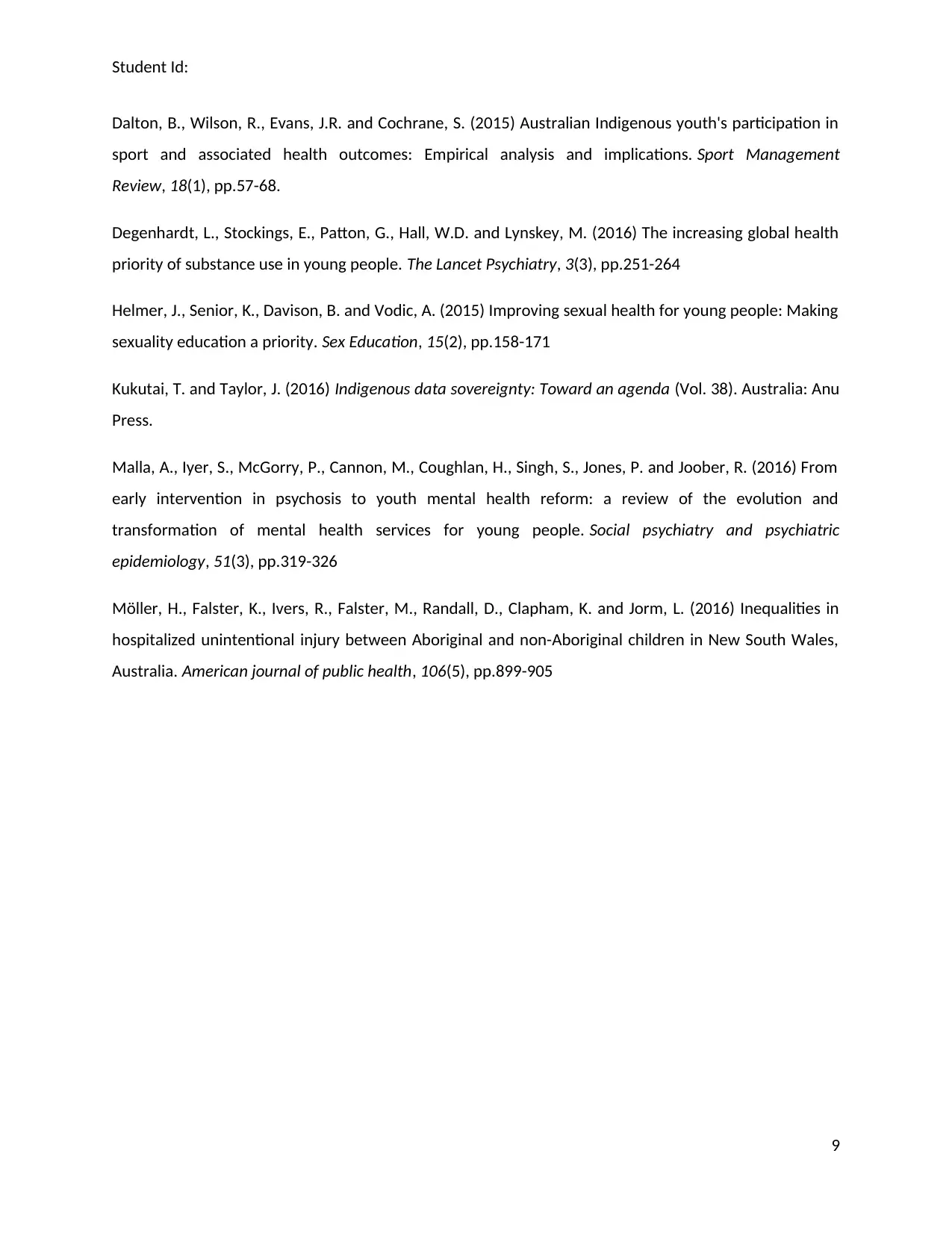
Student Id:
Dalton, B., Wilson, R., Evans, J.R. and Cochrane, S. (2015) Australian Indigenous youth's participation in
sport and associated health outcomes: Empirical analysis and implications. Sport Management
Review, 18(1), pp.57-68.
Degenhardt, L., Stockings, E., Patton, G., Hall, W.D. and Lynskey, M. (2016) The increasing global health
priority of substance use in young people. The Lancet Psychiatry, 3(3), pp.251-264
Helmer, J., Senior, K., Davison, B. and Vodic, A. (2015) Improving sexual health for young people: Making
sexuality education a priority. Sex Education, 15(2), pp.158-171
Kukutai, T. and Taylor, J. (2016) Indigenous data sovereignty: Toward an agenda (Vol. 38). Australia: Anu
Press.
Malla, A., Iyer, S., McGorry, P., Cannon, M., Coughlan, H., Singh, S., Jones, P. and Joober, R. (2016) From
early intervention in psychosis to youth mental health reform: a review of the evolution and
transformation of mental health services for young people. Social psychiatry and psychiatric
epidemiology, 51(3), pp.319-326
Möller, H., Falster, K., Ivers, R., Falster, M., Randall, D., Clapham, K. and Jorm, L. (2016) Inequalities in
hospitalized unintentional injury between Aboriginal and non-Aboriginal children in New South Wales,
Australia. American journal of public health, 106(5), pp.899-905
9
Dalton, B., Wilson, R., Evans, J.R. and Cochrane, S. (2015) Australian Indigenous youth's participation in
sport and associated health outcomes: Empirical analysis and implications. Sport Management
Review, 18(1), pp.57-68.
Degenhardt, L., Stockings, E., Patton, G., Hall, W.D. and Lynskey, M. (2016) The increasing global health
priority of substance use in young people. The Lancet Psychiatry, 3(3), pp.251-264
Helmer, J., Senior, K., Davison, B. and Vodic, A. (2015) Improving sexual health for young people: Making
sexuality education a priority. Sex Education, 15(2), pp.158-171
Kukutai, T. and Taylor, J. (2016) Indigenous data sovereignty: Toward an agenda (Vol. 38). Australia: Anu
Press.
Malla, A., Iyer, S., McGorry, P., Cannon, M., Coughlan, H., Singh, S., Jones, P. and Joober, R. (2016) From
early intervention in psychosis to youth mental health reform: a review of the evolution and
transformation of mental health services for young people. Social psychiatry and psychiatric
epidemiology, 51(3), pp.319-326
Möller, H., Falster, K., Ivers, R., Falster, M., Randall, D., Clapham, K. and Jorm, L. (2016) Inequalities in
hospitalized unintentional injury between Aboriginal and non-Aboriginal children in New South Wales,
Australia. American journal of public health, 106(5), pp.899-905
9
⊘ This is a preview!⊘
Do you want full access?
Subscribe today to unlock all pages.

Trusted by 1+ million students worldwide
1 out of 9
Related Documents
Your All-in-One AI-Powered Toolkit for Academic Success.
+13062052269
info@desklib.com
Available 24*7 on WhatsApp / Email
![[object Object]](/_next/static/media/star-bottom.7253800d.svg)
Unlock your academic potential
Copyright © 2020–2025 A2Z Services. All Rights Reserved. Developed and managed by ZUCOL.





